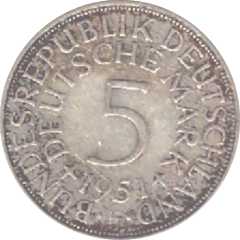
The German Mark (DM) - Earlier currency in Germany
Coin catalog > Germany > FRGMore than 15 years after its abolition, German Mark FRG continues to enjoy great popularity and is considered by many to be the strongest and most stable currency of all time.
This is not least related to the fact that the German mark actually is one of the most durable currencies of all times and at the same time managed to maintain moderate inflation. No other unused currency is being hoarded so much and collected like the German Mark of the Federal Republic of Germany. The Bundesbank still accepts the deutschmark and issues euros in exchange for the normal exchange rate.
Now and then a company even allows itself a marketing trick and suddenly accepts old D-Mark coins for a certain period of time, to attract customers and create positive associations. For example, Kaufland in 2016.
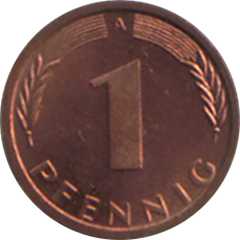 |
From the Bank deutscher Länder to the German BundesbankBefore the Deutsche Bundesbank was founded, the Bank Deutscher Länder served as the publisher of the Deutsche Mark after the founding of the FRG. Until 1951, the Bank of German Lands was under the direction of the Allies, after 1951 the institution achieve its sovereignty. That means they are in the subsequent period was not subject to the instructions of the Federal Government, but was independent.In fact, it is considered the successor of Reichsbank and should organize the monetary policy for the new Germany. On August 1, 1957, the Deutsche Bundesbank was finally founded. Which existed until today (albeit with different tasks). It grew directly from the bank of German countries and continued the coinage of the German Mark and Pfennige of the FRG away. |
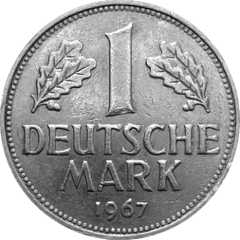 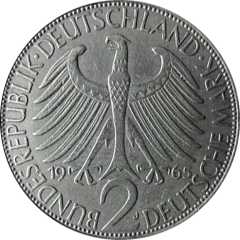 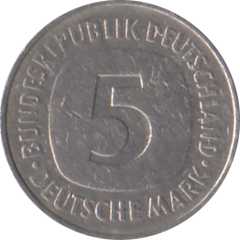 |
The coin image of the circulation coins of the Deutsche MarkCoin catalog > Germany > FRG > Circulation coinsOn the front of the 1 to 10 Pfennig coins of the FRG is the face value and the word Pfennig, framed by two ears of corn as well as the mint mark. The reverse side is marked by an oak branch with five leaves. In addition, here is the year of the coinage. The design of the Oak branches with the five leaves is made by the sculptor Adolf Jäger, who gained notoriety in Germany due to his work as "Pfennig-Jäger". On the 50 Pfennig piece, the picture shows the art teacher and painter Gerda Johanna "Jo" Werner, who, as seen on the coinage, looks like a model served for the "tree planter". The design itself is by Richard M. Werner. The front of the 1 DM coins is different from those of the Pfennig. In the middle are below the denomination the words "German Mark", framed by two ears of corn. Below is the year of the year to be read. On the back of the 1 Mark coin is the federal eagle, framed by the words "Federal Government of Germany". Below the eagle the mintmark is imprinted. The design of the 2 DM coin differed in the early days of the FRG only with regard to the higher denomination, but otherwise was identical as the 1 DM coin. Due to this circumstance, there was often confusion in the cash transactions, which is why it was decided to change the motif of the back of the 2 DM coins. The designs of the first German 2 DM coin and the 1 DM coin were both designed by the religious scholar and publicist Josef Bernhart. In 1958, the first new 2 DM piece came into circulation. On the picture side of this coin is the portrait of the physicist Max Planck, the founder of the Quantum mechanics. From 1969, the back of the 2 DM coin was changed again and again. Although the coin resembled the picture of Max Planck not anymore the 1 DM coin, but was often confused with the 5 DM coin. In the years of their coinage they caused countless errors in payment transactions and at financial institutions. In addition to the follow-up coin issued in 1969, the motif of the first German Chancellor Konrad Adenauer wore, appeared in the following years different 2 DM coins in parallel as valid means of payment. From 1970 to 1987 was the 2 DM coin with a picture of the first Federal President Theodor Heuss embossed. However, the first edition took place only after the beginning of the coinage, namely, on July 1, 1973. From 1979 to 1993, the 2 DM coin appeared to the first opposition leader Kurt Schumacher after a design by Hans-Joachim Dobler. From 1988 to 2001 the head of Ludwig Erhard, The founder of the social market economy, graced the reverse on another 2 DM circulation coin. The design of this coin comes from the Munich Franz Müller. From 1990 to 2001, the Federal Republic left the 2 DM coin with a picture of Franz Josef Strauß shape. Strauss was Bavarian Prime Minister and Federal Minister. The most recent 2 DM coin of the FRG originates from the sculptor Hubert Klinkel and shows the old chancellor Willy Brandt, who was in the highest political office from 1969 to 1974. The completion of the circulation coins of the Federal Republic forms the Fünf Mark Coin. The design is by the engraver Albert Holl. On the front the denomination of the words "Federal Republic of Germany" and "German Mark" is framed. On the back of the federal eagle can be seen. 1975 The design was changed to a design by Wolfgang Doehm. The font text is now no longer two lines and on the back of the eagle has become smaller, now the year of embossing can be seen underneath. |
What does the Pfennig and the German Mark of the FRG consist of?
The 1 Pfennig pieces of the Federal Government consisted of steel with a Copper sheath. The manufacturing process was very crude and inexpensive, so that the coins were susceptible to moisture and could be easily bent. The 2 Pfennig coins were made of bronze until 1967 (or a 95% copper alloy), which made them solid and valuable. Thereafter, the same procedure with the same material as in the 1 Pfennig piece applied. The 5 Pfennig pieces of Germany in turn consisted of steel with a brass coat, as well as the 10 Pfennig pieces. The 50 Pfennig piece was made of copper-nickel, the same material, which was also used in the 1 DM coin and the first 2 DM coin.From the Konrad Adenauer 2 D-Mark coin, a Magnimat made of copper-nickel was used. The 5 DM coins of the Federal Government consisted of 625 silver and 375 copper in the first embossing series and copper-nickel in the second embossed series. Their dimensions remained unchanged at 29 millimeters in diameter, however, the weight decreased by 1.2 grams to only 10 grams.
DM commemorative coins of the FRG from 1953 to 1967
Coin catalog > Germany > FRG > Memorial coinsIn the years 1953 to 1967, only five different commemorative coins in the Federal Republic of Germany were stamped in small editions and at the nominal value of 5 DM. Due to their rarity, these coins are now extremely sought-after objects among collectors. Only 200,000 pieces were total of the first 5 DM commemorative coin on the 100th anniversary of the Germanischen Nationalmuseums (Nuremberg) has been issued. The coinage took place in the Bavarian Main Münzamt in Munich. The second 5 DM commemorative coin for the 150th anniversary of the death of Friedrich Schiller was produced by the Staatliche Münze Stuttgart. The Mint in Karlsruhe coined in the same year the third 5 DM collectors coin of the FRG, here was the 300th birthday of the so-called "Türkenlouis" Ludwig Wilhelm, Markgraf von Baden the occasion for creating the motif of the coin. In 1957, the fourth of the West German mint prizes was coined by the Hamburgische Münze a 5 D-Mark commemorative coin. The motif was the 100th anniversary of the death of the Joseph von Eichendorff, An important lyric poet and writer of the Romantic period. Seven years later, the last 5 DM limited-edition commemorative coin was minted in the same mint. It commemorated the 150th anniversary of the death of Johann Gottlieb Fichte, a philosopher and representative of German idealism.
DM commemorative coins of the FRG from 1967 to 2001
Coin catalog > Germany > FRG > Memorial coinsIn the period from 1967 to the introduction of the euro as cash a total of 82 different commemorative coins were coined. Until 1979 it was 23 5 DM coins Made of 62.5% pure silver with a 37.5% copper addition. These had a diameter of 29 millimeters at a weight of 11.2 grams. Topics included the German Archaeological Institute, the birth or death days of famous people such as Friedrich Ebert or Albert Schweizer as well as special occasions such as the European Year of Historic Monuments or the anniversary of the German Basic Law. From 1980 to 1986, the federal government let more 15 commemorate five D-Mark coins make. These consisted of 75% copper and 25% nickel with a Magnimat. Her weight was at a diameter of 29 millimeters with ten grams. In addition to the 5 Mark commemorative coins were also issued 10 DM coins. From 1970 to 1972 appeared six different Coins made of 72.5% silver, with 37.5% copper content. Their weight was 15.5 grams with a diameter of 32.5 millimeters each. Events were exclusive Olympiads. From 1987 to 1997 another 23 Ten DM coins were made in the same material composition, but on other occasions as special Events or birthdays and deathdays of famous persons spent. Another difference of these 10 DM coins is that these are not like the previous 10 DM commemorative coins of all four West German Mint, but only one of them were coined. Exceptions were the last three DMs Coins in this material composition from 1997. These were made by the now five mints of the FRG. From 1998 to 2001 put the Federal Government additional 14 Ten Mark commemorative coins. Weight and diameter were the same as in the previous coins, this time was the however, silver share 92.7% and the copper content 7.5%. The coinage again took place in all five mints in Germany. On July 26, 2001 was also added a 1 DM gold coin of pure gold in an edition of one million pieces issued in memory of the Deutsche Mark, in equal parts of all five mints were issued. The weight was 12 grams, with a diameter of 32.5 millimeters.